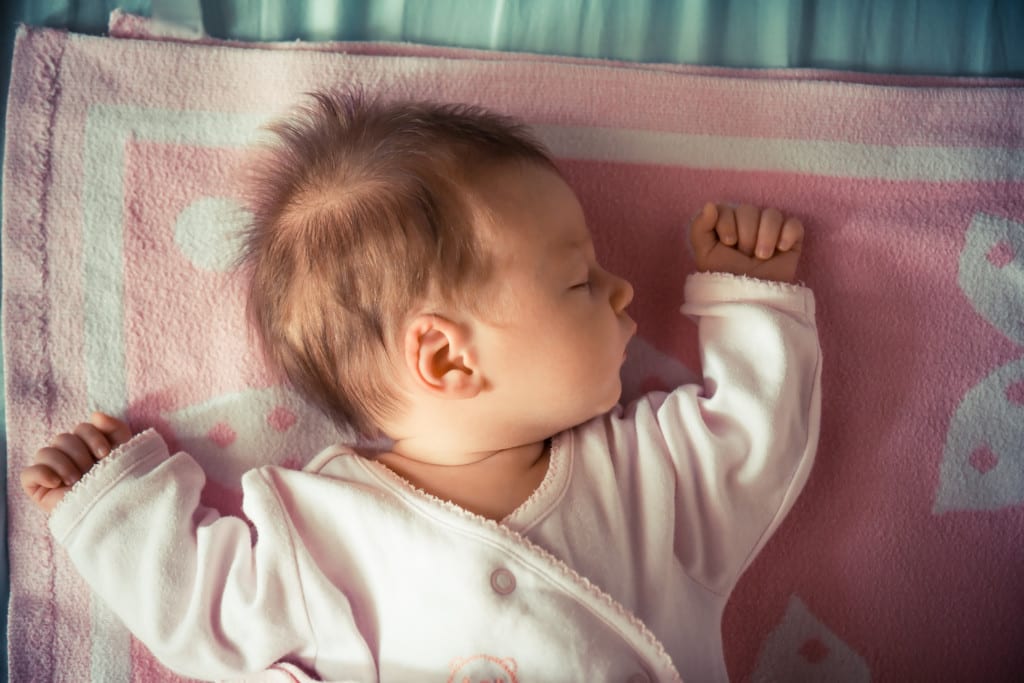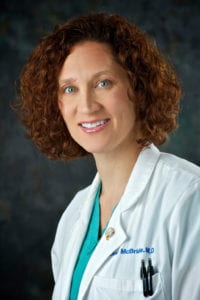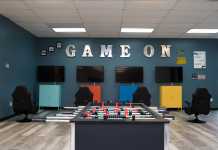Disclosure :: this post is sponsored by Children’s Hospital.
The Truth About Head Shape Abnormalities
Head shape abnormalities are among the most common problems we deal with in the Neurosurgery clinic at Children’s Hospital. Babies’ head shapes can cause concern for both parents and pediatricians alike. Determining whether a baby has a serious skull problem that may need surgery or just a temporary issue can be tricky. Fortunately, the most common cause of abnormal head shape is what is called posterior plagiocephaly, which is also known as positional plagiocephaly, positional skull molding or occipital flattening. All of these terms mean the same thing – flattening of the back of the head on one or both sides.
Before we get into that, let’s discuss why this problem seemed to come out of nowhere about 25 years ago. Decades ago, when most American babies slept on their stomachs, there was very little positional skull molding. In the mid-1980’s, Sudden Infant Death Syndrome, or SIDS (commonly called “crib death”) was found to be caused at least partly by sleeping in the face-down position. Because of this, in 1992 the American Academy of Pediatrics (AAP) issued an official recommendation that babies be positioned on their backs to sleep. This was later named the “Back to Sleep” or “Safe to Sleep” campaign. When these recommendations are followed, they work very well. Back to Sleep has decreased the incidence of SIDS by 50% in the US, so it really is much safer for babies to sleep on their backs.

Soon afterward, those in pediatric neurosurgery began to see an increasing number of babies with flattening of the back of the head, due to this new supine (on the back) sleeping position. Basically, to keep the babies safe from a life-threatening issue (SIDS), we accept that some of them will have a non-life-threatening issue that’s usually temporary (positional skull molding). When this happens, parents are often very concerned that the flattened skulls might cause their children to be picked on later in life, or worse – that it will impede proper brain growth. There is a lot of misinformation out in the world (and in cyberspace) suggesting that these children can develop high intracranial pressure, learning disabilities or even death from positional skull molding. None of these things are true.
There are really only 3 main concerns in babies with occipital flattening:
- Distinguishing it from actual fusion of the skull bones known as craniosynostosis (a separate disease that requires surgical correction)
- Preventing cosmetic problems for the baby later in life
- Ruling out an underlying cause of the flat skull that needs to be addressed, usually a neck problem called torticollis
Let’s talk about each of these three topics:
Craniosynostosis (aka Synostosis)
Craniosynostosis (aka Synostosis) is the fusion of one or more of the joints (sutures) between the skull bones. This restricts skull growth in some directions, resulting in an unusual head shape. There are different abnormal shapes, depending on which suture is fused. Usually, it’s possible to tell synostosis from positional skull molding just by examining the baby, but at times, X-rays or CAT scans are necessary. Here are some general rules:
- Synostosis is present before birth (not caused by delivery) and only worsens with time. These babies are born with an abnormal head shape.
- Most babies with positional plagiocephaly have a round head shape at birth and begin to change at 2-4 months of age. If the baby lies flat on the back of the head, the entire back of the head flattens symmetrically. If the baby lies more on one side, he or she will develop a “rhomboidal” head shape, where one side of the skull is skewed forward. This is different than the head shapes seen with craniosynostosis. Your pediatrician can help evaluate this or can refer you to a pediatric neurosurgeon if needed.
Preventing cosmetic problems later in life
Preventing cosmetic problems later in life — for most babies with positional plagiocephaly, the best way to fix the flattening is to remember what caused it — positioning. Get them off the flat area as often as possible SAFELY. Do NOT stop doing “Back to Sleep” until your pediatrician says it’s safe. When your baby is awake, keep him on his tummy often (tummy time) or in a baby seat or swing that makes him hold his head up.
Torticollis
Torticollis is an abnormality in the neck muscles that babies are sometimes born with. It prevents the baby from turning its head fully, so the baby is forced to lie on one side of its head. This can cause very significant skull flattening, even though the skull sutures are normal. Torticollis usually results in the baby keeping its head turned to one side AND keeping one ear tipped downward (toward the shoulder). A baby should be able to turn his head so that the chin almost touches the shoulder on both sides. If your baby needs to turn his or her trunk to look to one side, the baby may have torticollis.
Torticollis can usually be treated with stretching done by a physical therapist. Make sure your therapist has experience treating babies. For the therapy to work, it must make the baby uncomfortable, so don’t worry if your baby cries at first. If your baby isn’t crying during therapy, then it’s not being done effectively! Usually the therapists can teach you how to do most stretches, and you can do them at home after a few appointments, which speeds up the improvement. If your therapist feels that physical therapy alone isn’t resolving the problem, don’t despair! The muscle can be injected with medication to loosen it. In rare cases, surgery is needed to release the muscle. These treatments are all available at Children’s Hospital. Once the muscle has better range of motion and the baby can turn its head more freely, your baby’s head will round out on its own.
Skull Molding Helmets
Lastly, many parents ask about obtaining skull molding helmets. Helmets are used after certain surgeries for true craniosynostosis, but their use for positional plagiocephaly has always been controversial. In 2016, the Congress of Neurological Surgeons (CNS) published recommendations for treatment of positional skull molding. To summarize their findings, most babies can be successfully treated with positional manipulations and physical therapy. Helmets are only recommended for cases of severe plagiocephaly diagnosed later than 8 months old, or when repositioning and PT have been tried and failed. The vast majority of babies with positional skull molding never need a helmet, but buyer beware: helmet companies are quick to sell helmets to worried parents. Before paying thousands of dollars for helmet therapy, talk to your pediatrician or neurosurgeon.
The pediatric neurosurgeons at Children’s Hospital have more combined experience than any other hospital in the state. If you have questions about your baby’s head shape, feel free to make an appointment with our neurosurgeons at (504) 896-2888, or speak to someone in the Neurosurgery Department at (504) 896-9568.
About Lori McBride, MD
 Dr. McBride is Board Certified in both adult and pediatric neurosurgery and is an Assistant Professor of Neurosurgery at LSU Health New Orleans. She is the Chief of Neurosurgery at Children’s Hospital, where she has been practicing for 12 years. Dr. McBride has over 17 years of experience in her field.
Dr. McBride is Board Certified in both adult and pediatric neurosurgery and is an Assistant Professor of Neurosurgery at LSU Health New Orleans. She is the Chief of Neurosurgery at Children’s Hospital, where she has been practicing for 12 years. Dr. McBride has over 17 years of experience in her field.

















We did a helmet or DOC band. He wore it for 3 months and the results were amazing. So glad we did it.